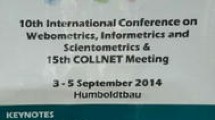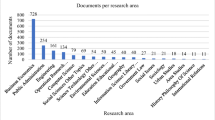Abstract
There is a burgeoning interest among academic scientists and policy-makers in the development and employment of TH (Triple Helix) and WSI (Webometrics, Scientometrics, and Informetrics) research methods. However, the international literature has not systematically examined TH and WSI approaches in an Asian context. Furthermore, previous literature published in international journals does not adequately address the social forces shaping TH development in Asia. Therefore, the purpose of this special issue is to bring researchers together to discuss university-industry-government (U-I-G) relations and innovation diffusion in Asia employing WSI alongside other methods.
Similar content being viewed by others
References
Björneborn, L., & Ingwersen, P. (2004). Toward a basic framework for webometrics. Journal of the American Society for Information Science and Technology, 55(14), 1216–1227. doi:10.1002/asi.20077.
Cho, S. E., & Park, H. W. (2011). Government agencies’ innovative use of the internet: The case of the twitter activity of south korea’s ministry for food, agriculture, forestry and fisheries. Scientometrics. doi:10.1007/s11192-011-0519-2.
Choi, S. (2011). Core-periphery, new clusters, or rising stars?: International Scientific Collaboration among ‘Advanced’ Countries in the era of Globalization. Scientometrics. doi:10.1007/s11192-011-0509-4.
Choi, S., Park, J.-Y., & Park, H. W. (2011). Using social media data to discover communication process within online innovation communities in South Korea. Scientometrics. doi:10.1007/s11192-011-0514-7.
Etzkowitz, H., & Leydesdorff, L. (2000). The dynamics of innovation: From National Systems and “Mode 2” to a triple helix of university-industry-government relations. Research Policy, 29(2), 109–123. doi:10.1016/s0048-7333(99)00055-4.
Foray, D., & Lundvall, B.-A. (1996). The knowledge-based economy: From the economics of knowledge to the learning economy. In D. Foray & B.-A. Lundvall (Eds.), Employment and growth in the knowledge-based economy (pp. 11–32). Paris: OECD.
Gibbons, M., Limoges, C., Nowotny, H., Schwartzman, S., Scott, P., & Trow, M. (1994). The new production of knowledge, the dynamics of science and research in contemporary societies. London: Sage.
Hossian, D., Moon, J., Kang, H. G., Lee, S. C., & Choe, Y. C. (2011). Mapping the dynamics of knowledge base of innovations of R&D in Bangladesh: Triple helix perspective. Scientometrics. doi:10.1007/s11192-011-0507-6.
Khan, G. F., Cho, S. E., & Park, H. W. (2011). A comparison of the Daegu and Edinburgh musical industries: A triple helix approach. Scientometrics. doi:10.1007/s11192-011-0504-9.
Khan, G. F., & Park, H. W. (2011). Measuring the triple helix on the web: Longitudinal trends in the university-industry-government relationship in Korea. Journal of the American Society for Information Science and Technology. doi:10.1002/asi.21595.
Kim, H., Huang, M., Jin, F., Bodoff, D., Moon, J., & Choe, Y. C. (2011). Triple helix in the agricultural sector of the Northeast Asian Countries: Comparative study between Korea and China. Scientometrics. doi:10.1007/s11192-011-0517-4.
Kim, M., & Park, H. W. (2011). Measuring twitter-based political participation and deliberation in the South Korean context by using social network and triple helix indicators. Scientometrics. doi:10.1007/s11192-011-0508-5.
Kondo, M. (2011). A public research institute that created and led a large industrial group in Japan. Scientometrics. doi:10.1007/s11192-011-0505-8.
Kwon, K.-S., & Martin, B. R. (2011). Synergy or separation mode: The relationship between the academic research and the knowledge-transfer activities of Korean academic. Scientometrics. doi:10.1007/s11192-011-0513-8.
Kwon, K.-S., Park, H. W., So, M. H., & Leydesdorff, L. (2011). Has globalization strengthened South Korea’s National Research System? National and international dynamics of the triple helix of scientific co-authorship relationships in South Korea. Scientometrics. doi:10.1007/s11192-011-0512-9.
Lee, Y.-G. (2011). Strengthening competency linkage to innovation at Korean universities. Scientometrics. doi:10.1007/s11192-011-0497-4.
Lee, M., & Park, H. W. (2011). Exploring the web visibility of world-class universities. Scientometrics. doi:10.1007/s11192-011-0515-6.
Lei, X.-P., Zhao, Z.-Y., Zhang, X., Chen, D.-Z., Huang, M.-H., & Zhao, Y.-H. (2011). The inventive activities and collaboration pattern of university-industry-government in China based on patent analysis. Scientometrics. doi:10.1007/s11192-011-0510-y.
Leydesdorff, L. (2001). Indicators of innovation in a knowledge-based economy. Cybermetrics, 5(1), Paper 2.
Leydesdorff, L. (2003). The mutual information of university-industry-government relations: An indicator of the Triple Helix dynamics. Scientometrics, 58(2), 445–467. doi:10.1023/a:1026253130577.
Leydesdorff, L. (2011). Application of TH model and indicator to various interfaces among three nodes with different functions. H. W. Park. TH 2011 conference in Stanford University.
Liang, L., Chen, L., Wu, Y., & Yuan, J. (2011). The role of Chinese universities in enterprise-university research collaboration. Scientometrics. doi:10.1007/s11192-011-0503-x.
Lundvall, B. A. (1992). National systems of innovation: Towards a theory of innovation and interactive learning. London: Francis Printer.
Nelson, R. (1993). National innovation systems: A comparative analysis. Oxford: Oxford University Press.
Sams, S., Lim, Y. S., & Park, H. W. (forthcoming). E-research applications for tracking online socio-political capital in the Asia-Pacific region. Asian Journal of Communication.
Shapiro, M. A. (2011). Receiving information at South Korean and Taiwanese universities, industry, and GRIs. Scientometrics. doi:10.1007/s11192-011-0501-z.
Shapiro, M., & Park, H. W. (2011). Regional development in South Korea: Accounting for research area in centrality and networks. Scientometrics. doi:10.1007/s11192-011-0498-3.
Shin, J. C. Higher education development in Korea: A comparative perspective from East Asian higher education. Higher Education in press.
Shin, J. C., Lee, S. J., & Kim, Y. (2011). Knowledge-based innovation and collaboration: A Triple-helix approach in Saudi Arabia. Scientometrics. doi:10.1007/s11192-011-0518-3.
Soon, C. (2011). Editorial introduction. Social Science Computer Review, 29(3), 275–276.
Tague-Sutcliffe, J. (1992). An introduction to informetrics. Information Processing and Management, 28(1), 1–3.
Thelwall, M. (2009). Introduction to webometrics: Quantitative web research for the social sciences. New York: Morgan and Claypool.
Author information
Authors and Affiliations
Corresponding author
Rights and permissions
About this article
Cite this article
Khan, G.F., Park, H.W. Editorial: Triple Helix and innovation in Asia using scientometrics, webometrics, and informetrics. Scientometrics 90, 1–7 (2012). https://doi.org/10.1007/s11192-011-0506-7
Received:
Published:
Issue Date:
DOI: https://doi.org/10.1007/s11192-011-0506-7




